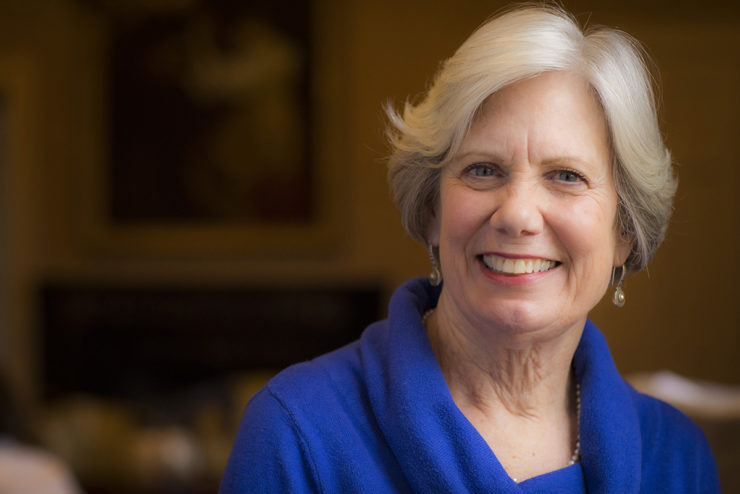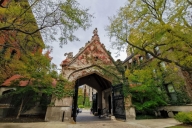You have /5 articles left.
Sign up for a free account or log in.

Statue of Francis Asbury, a Methodist bishop, on the campus of Drew University
Drew University/Lynne DeLade
Faced with tight budgets, a nagging deficit and a reduced endowment, Drew University, a small, private liberal arts institution west of New York City, has opted to expand -- not trim -- academic offerings. To reduce its operating budget, Drew is cutting, among other line items, cops and sippy cups.
President MaryAnn Baenninger (right) said the university has refused to cut virtually any student-facing programs. “Our plan has been to grow and then get more efficient,” she said.
On the chopping block: nonacademic expenses and fringe benefits for faculty and staff ranging from public safety to retiree health-care subsidies to daycare.
Baenninger said aggressive cost-cutting should close Drew’s funding gap in three years. But instead of cutting academics, Drew has pushed to woo new students by creating new undergraduate majors in media and communications, public health, and cybersecurity, as well as master’s-level programs in finance and education. It added men’s and women’s golf teams and is redesigning its theological school curriculum.
Earlier this month, Baenninger told students, faculty and alumni that a new undergraduate program, dubbed Launch, slated for fall 2019, will guarantee “real-world, résumé-ready experiences” such as internships, hands-on research and residencies in cities like London, New York and Washington. (The effort’s motto: “Put the ‘Hire’ in Higher Education.”) She didn't publicly announce the anticipated cuts.
In a message to the campus, Baenninger said Launch arose, in part, from an effort to understand why some prospective students don’t choose Drew -- and how others who do “experience more difficulty than others in translating their successes at Drew into a meaningful career arc.”
The only actual programmatic cut that Baenninger has recommended: a low-residency, master’s-level poetry program that enrolls nine students. They’ll complete their degrees, but the program will not accept new recruits. Otherwise, she said, Drew plans cuts in mostly non-student-facing areas. It doesn't foresee any faculty reductions.
When Baenninger arrived four years ago, the college’s plan was to tame its growing deficit and shrinking endowment by cutting several academic programs.
“It didn’t actually make sense to me,” Baenninger said, noting that many of the majors then on the chopping block had high market demand. Instead, her staff searched “in a surgical way” for areas that had large numbers of employees but that weren’t contributing to instruction.
Among the two biggest areas: public safety and childcare.
The university plans to outsource operation of a long-standing, highly subsidized childcare center that serves dozens of campus and area families, but that “loses six figures every year -- some years it costs us $300,000,” Baenninger said. Those funds, she said, come almost entirely from undergraduate and graduate tuition proceeds. Drew expects to cut 56 positions across several areas, including childcare.
“In my view, as much as I understand why day care is very, very important -- and we’ll look at that moving forward -- I have to steward our tuition dollars as best I can,” Baenninger said.
The childcare center won’t go away -- Drew will find ways to outsource its operation. The university hasn’t yet figured out whether it will subsidize the new entity.
Addressing the safety issue, Baenninger said Drew, which sits on a wooded 186-acre campus in Madison, N.J., a tony suburb 25 miles west of New York City, is already safe -- in an interview, she said with a little laugh that she could anticipate the next question: Isn’t Drew safe because it spends so much on keeping trouble out?
“We’re a very, very safe campus, but we were putting more resources into that than our peer institutions were,” she said. A benchmarking study found that Drew had about twice as much public safety staff as comparable colleges, meaning that on occasion small skirmishes or incidences of misbehavior are met with an overwhelming response.
She has also combined the university’s career center with its study abroad, civic engagement and student research offices, in the process hiring a new director.
And Drew cut some health benefits for retirees and their dependents.
Reducing these bedrock benefits is difficult for the community, she said, “but they were a long time coming” and had to be considered to keep academic programs afloat.
“Everything we’re cutting is not mission-central,” she said. “There are things that had been part of our ethos and our culture for a long time -- we want to shift the resources that we used for them towards student-focused programs.”
Professor Sarah Abramowitz, who chairs Drew's math department, said she has spoken to colleagues who are “very sad to lose some of these benefits that they really care about,” especially valuable childcare subsidies that many younger faculty and staff have come to rely upon. But she said most see the bigger picture. “Other schools are experiencing the same problems, but the way they’re doing it is by cutting programs,” she said. Those can easily create a “downward spiral” that spells the end of institutions like Drew, making them less, not more appealing to new students.
“As we grow our enrollments, we’re going to solve our fiscal problems,” Abramowitz said.
The changes follow several years of bleak financial news for Drew, which was established in 1867 as a Methodist seminary and eventually became a small college for men.
Former New Jersey governor Thomas Kean led the school for 15 years, from 1990 to 2005, expanding the campus while growing Drew’s endowment. But by the time Baenninger arrived in 2014, the university had an $11.1 million operating deficit -- which soon grew to $13.7 million, or about 15 percent of spending.
In 2015, as she pushed to reinvigorate the university, Baenninger told faculty, "The ocean liner has stalled, and it's facing the wrong direction. It will take us four or five years to recover."
Since then she has spent heavily to turn Drew around, spending down the university’s endowment in the process -- it dropped 19.1 percent between 2015 and 2016, to $172.2 million, according to the National Association of College and University Business Officers and Commonfund. The trend has since reversed: the endowment now stands at $177.8 million, a 3.2 percent gain.
In March 2017, Moody’s Investors Service downgraded Drew’s bonds for the second time in 15 months, dropping one series from Ba3 to B2 and two others from Ba3 to B3. Moody’s said Drew’s operating deficits would likely last longer than expected -- analysts predicted that Drew’s financial outlook would remain “challenged” for several years, making a return to financial stability “very difficult.”
Drew later took its debt private, removing it from Moody’s gaze.
Reflecting on the downgrades, Baenninger said the ratings agency “would have felt better if we cut first and then grew -- but the board and I didn’t believe that would work.”
As part of her plan to bring in more revenue, Baenninger hired Robert Massa as senior vice president for enrollment and institutional planning. Massa had previously helped Pennsylvania’s Dickinson College turn around its enrollment and revenue.
Since his arrival, freshman enrollment has grown, from 302 in 2015 to 420 this fall, just short of Drew’s goal of 430.
Next fall, Baenninger said, Drew needs 470 new students to meet anticipated expenses. By 2021, the university needs a “steady state” of 500 new students each fall.
Drew also reset tuition this fall to 2010 levels, lowering it 20 percent. Its discount rate, meanwhile, has fallen, from 67 percent in 2015 to 57 percent this fall -- discount rates typically fall when institutions reset tuition.
Baenninger said more revenue and lower spending could wipe out Drew’s deficit by 2021. The following year, she said, she anticipates making larger deposits to the endowment.
“It’s going to be a few years before we start to recover from the stagnancy because of the dollars we’ve had to use,” she said. “And our budget plans to make extraordinary deposits to the endowment starting in 2022.”
In the meantime, she said, alumni giving is up -- Drew’s annual fund grew 37 percent this year, to $1.6 million. One donor challenged the university to raise an additional $4 million within six months. If they did, he promised, he’d add $1 million to the total.
“We did -- and he did,” Baenninger said.
Brett Frazier, chief commercial officer at Ruffalo Noel Levitz, the enrollment management and consulting company, said he couldn't comment specifically on Drew's changes. But he said more generally that institutions like Drew shouldn't just propose new offerings “every decade or two” -- they should re-evaluate both their offerings and price “on a more consistent and frequent basis.”
Universities that remain student-focused, regardless of how markets are changing, “typically do quite well and come out ahead of their peers,” he said. He also said universities that focus on personally appealing to everyone from prospective students to alumni "and everyone in between" are typically more successful.
“We expect personalization in every other aspect of our lives, and we know that personalization is possible primarily through data and analytics,” Frazier said.
His colleague Brian Gawor, Ruffalo's vice president for research, said asking students and families “what they want and how they want it delivered” is a huge key to success. Families like those that consider Drew are looking for institutions that focus on individual student success, not just recruitment, he said. "Americans are demanding more of higher education."
One of the key metrics universities should consider, he said, is student engagement -- not just in course work but in everything, from clubs and organizations to how often a student uses campus dining facilities and, on a deeper level, how engaged a student is with classmates who are different than she is.
“If we’re going to provide a life-changing experience, let’s talk about the things that are truly life-changing,” Gawor said.
David Strauss, a principal at Art & Science Group, a Baltimore-based consulting firm that advises universities on strategy, said each institution must preserve the “core of your reason for being.” Other expenditures -- even those that employees have come to expect and rely upon -- aren’t necessarily worth keeping if they don’t accomplish this. “That often means that an institution has to prune at areas that are not at the core of its reason for being,” he said. Such cuts can be painful, especially if they serve the greater public or are highly valued, like day care or dependent health care. “But we have to take a step back strategically and realize that not all institutions can afford to be doing all things.”
Like Frazier and Gawor, Strauss wouldn’t comment specifically on Drew’s efforts -- Art & Science has consulted with the university on its Launch effort, for one thing. He said all institutions are “idiosyncratic,” and that virtually no solution will work across all of them. “Suffice to say that whenever you hear people say, ‘Institution X is doing this and it’s really working for them -- we should go do it too,’ they’re almost always wrong.”








